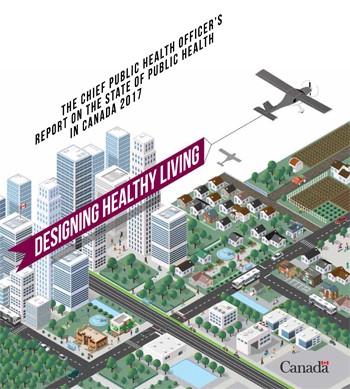New report underscores importance of local planning for healthy living

In her report, Designing Healthy Living, on the state of public health in Canada, Dr. Theresa Tam, Canada’s Chief Public Health Officer, examines the connection between where we live and our health. She explains how our built environment can impact our health by providing opportunities for us to make healthy or unhealthy choices in our everyday lives—choices that can have major and long-lasting impacts on our health. Our built environment is the physical environment around us: where we live, work, study and play. It includes buildings, roads, public transit systems, parks and other types of community infrastructure.
Dr. Tam lays out three important pillars for healthy living that can be influenced by where we live. “Our built environment can help to provide a foundation for healthy living,” Dr. Tam explained. “The design of our communities can promote opportunities for increased physical activity, easier access to healthy foods, and better mental health through social support and community belonging.”

Unhealthy and sedentary lifestyles can lead to higher rates of being overweight or obese, which in turn lead to higher rates of chronic diseases. Making choices like walking or biking to work or school and eating a healthier diet because we have easy access to healthy foods can make a big difference in our overall health. Only about one in three children in Canada get enough daily physical activity. Places that offer challenging play environments and safe routes to walk or cycle to school can help kids get the daily exercise they need.
Part of the challenge of transforming neighbourhoods to better support healthy living is related to regulatory barriers that have limited the ways in which neighbourhoods can be revitalized. But here too, communities are making remarkable progress. For example, a new municipal zoning designation in Toronto is allowing for mixed development in its many apartment tower neighbourhoods. This will allow for these neighbourhoods to have better access to healthy eating opportunities, places to be active and socialize with neighbours.
Dr. Tam’s report also draws attention to the importance of connectivity and social interactions for better mental health. Reports have shown that loneliness can take years off our life. Safe places to gather and socialize in neighbourhoods can help people feel connected. In her report, Dr. Tam explains that people who have a strong sense of community belonging are more likely to report having excellent or very good physical and mental health.
“This report answers some questions but also raises many others,” says Dr. Tam. “We need to work together collectively if we are to effectively measure the health impacts of community design and incorporate evidence-based strategies into community planning.”

The report calls for decision makers and planners at all levels to consider health an important outcome when making infrastructure planning decisions. The goal is to raise awareness among Canadians and to encourage dialogue across the many disciplines involved in community planning and health promotion.
By choosing and advocating for features that support healthy lifestyles, such as green spaces, efficient public transport and access to healthy and affordable food in their communities, Canadians can encourage a health approach to building and designing the neighbourhoods they live in.
The report is available at Canada.ca/CPHOReport.


